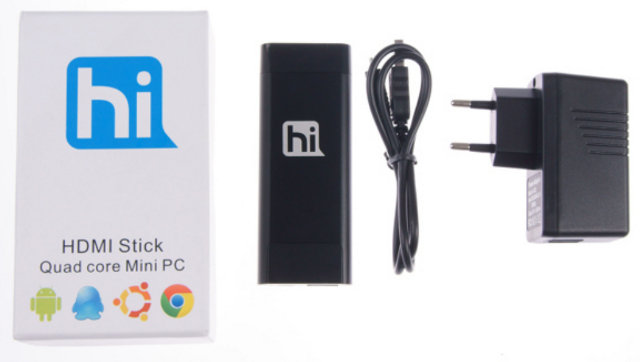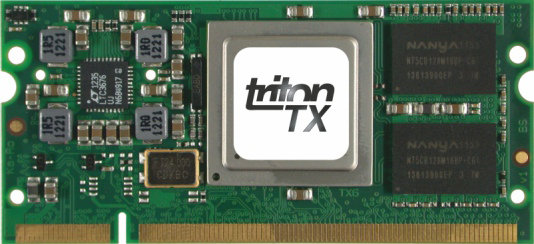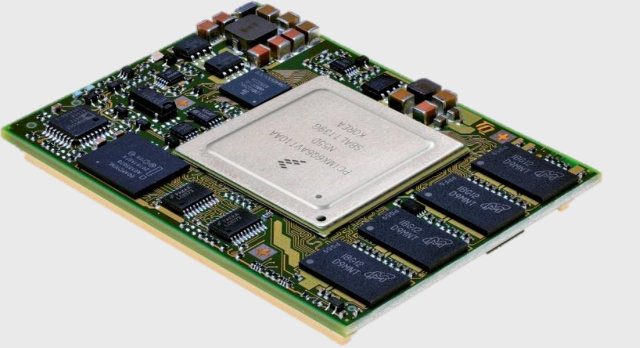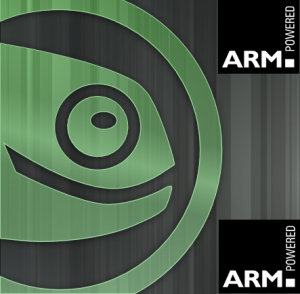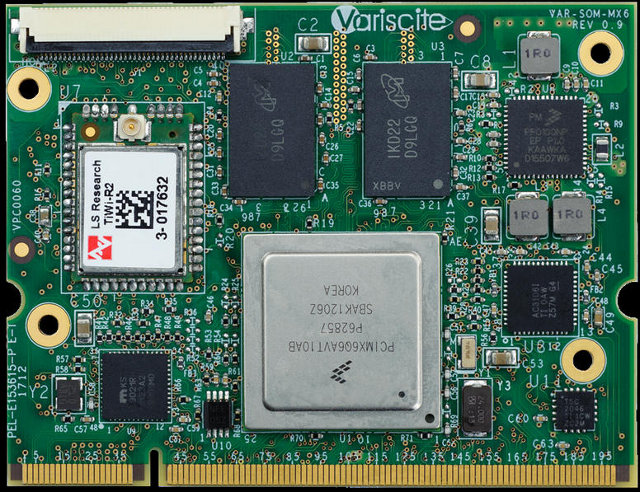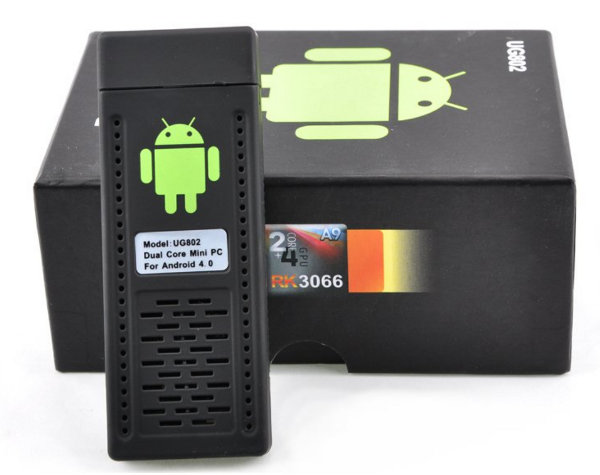After many delays allegedly due to Freescale i.MX6 CPU delivery issues, Hiapad HI-802 mini PC appears to be now available for purchase on Aliexpress for $99 including shipping. This HDMI dongle features Freescale i.MX6 Quad, 1GB RAM and 8GB Flash. The specs on Aliexpress are similar to the original announcement, except the internal NAND flash size is 8GB instead of 16GB: SoC – Freescale i.MX6 Quad Core Cortex A9 @ 1.2GHz with Vivante GC2000 System Memory – 1GB DDR3 RAM Storage – 8GB Nand Flash + microSD card socket Connectivity 802.11b/g/n Build-in Bluetooth 2.1 No 3G support. Video Output – HDMI (Up to 1080p60) Video Container Formats – 3GP,MPEG4,AVI,RMVB,MKV,FLV etc. support 1080P HD Resolution Audio Formats – MP3/WAV/AMR/AAC; USB – Micro USB 2.0 OTG + USB 2.0 Host Power Supply – 5V/1.5A Dimensions – 102 x 38 x 10 mm Weight – 45 g This Android 4.0 (ICS) mini PC […]
Direct Insight TRITON-TX6Q System-on-Module Powered by Freescale i.MX6Q
Direct Insight, a British company, has recently announced the TRITON-TX6Q, a SODIMM system-on-module based on Freescale’s iMX6Q quad core Cortex-A9 processor running at 1 GHz with 1 to 2GB RAM and 128 MB flash. This module targets embedded applications including medical devices, digital signage, and industrial multimedia products. Here are the TRITON-TX6Q specifications: SoC – Freescale i.MX6Q 4x ARM Cortex-A9 up to 1GHz + Vivante GC2000, GC355 and GC320 graphics co-processors System Memory – 1GB or 2GB 64-bit DDR3 @ 1066MHz Storage – 128MB NAND Flash, 2 SD card receptacles on baseboard Display Connection – LCD controller 24-bit parallel up to 1080p, dual LVDS (optional). Resistive & capactive touch screen support. Connectivity – Ethernet 10/100 BaseT with PHY on module. USB – USB Host + USB OTG Peripherals and Interfaces: Up to 5x UART (RS232) with pin sharing 2x I2C, 1x 1-wire and 2x SPI interfaces SSP (synchronous serial /digital audio): […]
TQ Group TQMa6X Embedded Modules based on Freescale i.MX6 Processors
TQ Group has recently unveiled several TQMa6X embedded CPU modules that feature Freescale i.MX6 Solo, Dual and Quad processors, targeting screen, multi-touch, and multi-display applications as well as conventional controlling tasks. 3 modules are available: TQMa6S-AA – Single Cortex A9 / 1,2 GHz, 2 GB eMMC Flash, 512 MB DDR3, 64 kB EEPROM, -25°C…+85°C TQMa6D – Dual Cortex A9 / 1,2 GHz, 2 GB eMMC Flash, 512 MB DDR3, 64 kB EEPROM, -25°C…+85°C TQMa6Q – Quad Cortex A9 / 1,2 GHz, 2 GB eMMC Flash, 1 GB DDR3, 64 kB EEPROM, -25°C…+85°C TQMa6X modules share the following specifications: Processor – Freescale MCIMX6 Single/Dual/Quad Cortex A9 up to 1,2 GHz System Memory – Up to 2 GB DDR3 SDRAM Storage – Up to 64 GByte eMMC Flash, EEPROM: 0 / 64 kbit and up to 128 MB NOR-Flash. System interfaces: CAN – 2x FlexCAN ESAI (Enhanced Serial Audio Interface) Ethernet – 1x 10/100/1000 Mbit (IEEE […]
Freescale i.MX6 Resources: Development Boards, Documentation, Source Code and Tools
Reader “Mark” recently left a comment saying the NDA on Freescale i.MX6 resources was lifted and documentation and source code were now available for the platform. So it’s time for me to look into it, and provide an overview of Freescale i.MX6 features, list available development platforms, and have a closer look at the documentation, source code and tools for the platform. Freescale i.MX6 Processors In 2011, Freescale initially announced 3 processors in the i.MX6 series for consumer, industrial and automotive markets, but added 2 lite SoC in 2012, and there are now 5 members in the family: Freescale i.MX6SoloLite – Single Cortex A9 processor up to 1 GHz with 256KB L2 Cache, 32-bit DDR3 and LPDDR2 memory support, and 2D graphics accelerator (Vivante GC355 + GC320) Freescale i.MX6Solo – Single Cortex A9 core up to 1 GHz with 512KB L2 Cache, 32-bit DDR3 and LPDDR2 memory support, and 2D & […]
Kontron ULP-COM-sAMX6i – Freescale i.MX6 Solo, Dual and Quad Computers on Module
Freescale i.MX6 series was first announced in January 2011, and there have been delays due to problem with the silicon, but now the i.MX6 processors are finally in mass production, and lots of different products are using this SoC. The latest product I found is ULP-COM-sAMX6i by Kontron which is a series of computers on module based on ULP-COM (Ultra Low Power) standard featuring Freescale i.MX6 solo, dual and quad processors. Those commercial and industrial grade modules target markets such as transportation, medical and military. Here are the technical specifications of the modules: CPU – Freescale i.MX 6 Single, Dual and Quad Core ARM Cortex-A9 @ 800 MHz (Industrial grade), 1 GHz and 1.2 GHz System Memory – Up to 2 GB DDR3 Storage – Optional onBoard NAND/eMMC up to 64GB Graphics / Video – Dual Display, HD 1080p Decode/Encode and 2D/3D acceleration Video Output Resolution Parallel LCD 18/24 bit […]
openSUSE 12.2 for ARM is Now Available for Beagleboard, Pandaboard, Efixa MX and More
The first stable release of openSUSE for ARM has just been announced. openSUSE 12.2 for ARM is officially available for the Beagleboard, Beagleboard xM, Pandaboard, Pandaboard ES, Versatile Express (QEMU) and the rootfs can be mounted with chroot, but “best effort’ ports have been made for Calxeda Highbank server, i.MX53 Loco development board, CuBox computer, Origen Board and Efika MX smart top. Work is also apparently being done on a Raspberry Pi port which should be available for the next release. openSUSE developers explains that almost all of openSUSE builds runs on these platforms (about 5000 packages). Visit “OpenSUSE on your ARM board” for download links and instructions for a specific ARM board. More details are available on the wiki page. openSUSE has limited resources for ARM development, so If you’d like to help with development (e.g. fixing builds), visit ARM distribution howto page to find out how to get […]
Variscite VAR-SOM-MX6 Freescale i.MX 6 Solo, Dual and Quad System on Modules Start at $59
Variscite has unveiled a new series of system on modules powered by Freescale i.MX6 Solo, Dual, DualLite and Quad processors with 512 to 2048 MB DDR3 RAM, and 128 to 1024MB SLC NAND Flash. Here are the modules key features: SoC – Freescale i.MX 6 series SoC (Single/Dual /Quad ARM® Cortex™-A9 Core, 1.2 Ghz) System Memory • Up to 16 Gb DDR3 RAM Storage – Up to 8 Gb NAND Flash for storage memory/boot Video Output: 2 x LVDS display interface HDMI V1.4 i nterface 1 x MIPI DSI Touch panel interface Camera – Parallel & serial camera interface (CSI) Connectivity On-board 10/100/1000 Mbps Ethernet PHY WLAN (802.11 b/g/n) Bluetooth 2.1 + EDR USB – 1 x USB 2.0 host, 1 x OTG Audio – Stereo line -In/out, digital & analog microphone, and S/PDIF In/Out Other interfaces: 2 x SD/MMC Serial interfaces ( SPI , I2C, UART, I2S,) 2x CAN […]
Rockchip RK3066 UG802 mini PC is Now Available for Just $46.50
Earlier today, a reader left a comment about a mini PC based on RK2908 sold for $40 including shipping on Ebay. No bad! But since I hadn’t checked mini PCs on Aliexpress for a few months, I decided to have a look for cheap devices. The cheapest sold by a company with decent feedback is the IP872 ($34 including shipping), but it’s based on an ARM11 chip (Infotmic IMAPX 200) and runs Android 2.3, so I don’t find it that interesting. There are also some AllWinner A10 mini PCs that cost just above $40 including shipping, but then I found one company selling UG802 for $46.50 including shipping via China Post. It’s quite shocking that the price halved within 3 months, and this makes single core mini PC that less attractive, unless you want to run Linux (Ubuntu, Debian…) which is not yet supported by RK3066. The device sold by […]


